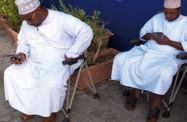Efforts to deepen the penetration of information and communications technology (ICT) in everyday life in Oman are gathering pace, with state-backed investments targeting improved and faster access to advanced applications. The government has been stepping up spending on ICT as part of its policy – formally launched in 2002 – of providing the private sector with the tools to expand and diversify as well as putting in place a state e-infrastructure to improve services provision to the public and promote the development of a knowledge-based economy.
Since 2002 many state services have been made available online, with a focus on health, education and social services and on improving and speeding up interaction between the private and public sectors.
Though Oman has taken major strides in improving services, there has been some concern that members of the public, especially those from lower-income families, might be left behind and be disadvantaged by a lack of ICT access. One measure to overcome this was unveiled late last year, when Sultan Qaboos bin Said Al Said announced a Royal Grant stipulating that a free laptop would be provided to every Omani family currently receiving social insurance benefits and that had at least one child attending school. The scheme also ensured that a free laptop would be given to students enrolled in higher education whose families are in receipt of social insurance.
These programmes, and other schemes to assist teachers and others involved in the education network, have seen some 113,000 computers distributed, with more to come, according to the Information Technology Authority (ITA).
However, rather than just putting technology out into the community, the state is backing these initiatives by providing support programmes, establishing training centres and labs across the country, increasing the emphasis on ICT training in schools and colleges, and improving the skills base of educators and public servants.
The success of this policy has been noted in the “Global Information Technology Report 2010-11”, issued in April by the World Economic Forum (WEF). Having eased its way up the rankings over the past few years, climbing from the 53rd on the ladder in 2007 to 50th in 2008 and again in 2009. Oman has jumped nine places over the past year to 41st out of the 138 countries assessed in the networked readiness index.
The Sultanate was ranked behind many of its near neighbours, such as the UAE, which was 24th; Saudi Arabia (33rd); and Bahrain (30th). However, Oman was by far the biggest mover in the region. Only Saudi Arabia came close to matching Oman’s rate of improvement, moving up from 38th place the previous year.
Noteworthy in the WEF report was Oman’s ranking of 13th globally in the category of government readiness, and outcome that is a sign of the importance of ICT to the government’s vision, the state’s prioritisation of ICT and its procurement of advanced technology to achieve its goals.
The WEF is not the only agency to notice the impact of the government’s e-readiness. In late June The ITA won a UN Public Service award in the category of “advancing knowledge management in government” for its e.oman communication strategy.
Despite the advances, the WEF report found that Oman was lagging somewhat in deploying the necessary infrastructure to boost its rankings, with access to broadband internet, fixed-line telephony and mobile telephone coverage below its overall grading, analysts believe this is set to change.
According to Sheila Jamal, the CEO of ICT firm Al Madina Development and Supply, Oman is starting to reap the rewards of its years of planning and investment. “Improving has been the government’s long-term strategy,” she told OBG. “They’ve taken some decisions that are now starting to give very positive results.”
Importantly, this push to integrate ICT into daily lives is doing much to overcome the difficulties of distance in Oman, bringing far-flung communities and agencies closer together. “With the topography making travel around the country rather long and challenging, the government made the decision to go digital,” said Jamal. “Things that used to require days can now be done electronically within minutes. Getting an ID or a driving licence used to take months, but now it is done within minutes.”
As one of the largest countries in the region, second only to Saudi Arabia among the GCC states in terms of area, and with a less urbanised population than most of its neighbours, ICT is seen by the government as a tool for connectivity, though it will take time to complete the linkages, said the ITA’s CEO, Salim Sultan Al Ruzaiqi.
“One of the main objectives of the IT sector nowadays is to bridge the digital divide between cities and villages,” he told OBG. “This can be partly resolved by introducing free internet and free IT training to some areas of the country. A full training programme already exists to teach citizens how to pay their bills online and how to use the basic e-government services, but more awareness opportunities are to be initiated.”
The next leap forward for Oman’s ICT sector will be improving broadband access, a shortcoming identified in the WEF study. According to Al Ruzaiqi, broadband will provide opportunities for businesses in the medium term and beyond.
“Broadband has been identified as the core strategy to provide better connectivity to Omanis,” he said. “The trend is turning towards mobile internet and this is where we see the strongest growth potential for the years ahead.”
It will still take time for Oman to bridge the gaps between town and country, though the continued investment in technology and infrastructure, not to mention that in the nation’s youth, is expected to change divides into dividends in the not-too-distant future.

